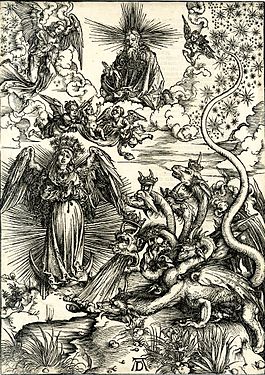Woman of the Apocalypse and the Seven Headed Dragon
7:00 AM |
| The Woman of the Apocalypse and the Seven Headed Dragon, Albrecht Durer, 1498 |
By HARPER TRUOG
The Woman of the Apocalypse and the Seven Headed Dragon is the 11th woodcut in a series called The Apocalypse. Each woodcut illustrates a passage from the revelations of St. John, which describe the end of the world. The Black Plague came in waves and ravaged Europe's population. The art from that period reflected the destructive power of the disease as people became well acquainted with death. Many people thought that the plague was a form of punishment and that the end of the world, or the Last Judgement, would occur in 1500. The Nun by Hans Holbein shows a woman who is kneeling to pray, but is distracted by a handsome man. Durer capitalized on the fear of death and going to Hell by vividly illustrating passages about the end of the world. Holbein's woodcut warns against being distracted by earthly possessions and attachments and Durer's woodcut shows the result of devotion.
The Woman of the Apocalypse and the Seven Headed Dragon connects to a passage of St. John. The passage describes a "woman clothed in sun" and a vision of God right before storms and earthquakes. The woman has a crown of 12 stars, is robed in sun, and has the moon beneath her feet. The dragon, which could represent Hell or death, waits to devour the child she is about to bear. Before the dragon can take the child, angels rescue it. The woodcut warns of the potential fate of people who die (they get eaten by the dragon), but it has a hopeful message at the end. If one lives a good and pure life, they will go to Heaven and be saved from suffering. In order to be saved, people would have to repent and prioritize their soul above all else.
0 comments